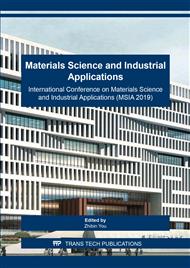[1]
Liang M.L., Surfactants and detergents: preparation, properties, applications. Scientific and Documentation Press. (1990).
Google Scholar
[2]
Das M., Sanson N., Kumacheva E., Zwitterionic poly(betaine-n-isopropylacrylamide) microgels: properties and applications. Chemistry of Materials. 20(22) (2008) 7157-7163.
DOI: 10.1021/cm801585x
Google Scholar
[3]
Hunter J.E., Fowler J.F., Safety to human skin of cocamidopropyl betaine: a mild surfactant for personal-care products. Journal of Surfactants & Detergents. 1(2) (1998) 235-239.
DOI: 10.1007/s11743-998-0025-3
Google Scholar
[4]
Petter P.J., Fatty acid sulphoalkyl amides and esters as cosmetic surfactants. International Journal of Cosmetic Science. 6(5) (2010) 249-260.
DOI: 10.1111/j.1467-2494.1984.tb00382.x
Google Scholar
[5]
Nada FilipovicVincekovic., Ion decontamination with a mixture of cationic and anionic surfactants. Journal of Radioanalytical & Nuclear Chemistry. 99(1) (1986) 89-96.
DOI: 10.1007/bf02060829
Google Scholar
[6]
Hua T.U., Rui-Lin M., Wei-Ping C., The development of the multi-purpose amphoteric surfactant of cocoamidopropyl betaine. Detergent & Cosmetics, 24(1) (2001) 44-46.
Google Scholar
[7]
Wilson., Ashley., Foams: physics, chemistry, and structure. Springer London. (1989).
Google Scholar
[8]
Britta M.Folmer., Kronberg B., Effect of surfactant−polymer association on the stabilities of foams and thin films: sodium dodecyl sulfate and poly(vinyl pyrrolidone). Langmuir. 16(14) (2000) 5987-5992.
DOI: 10.1021/la991655k
Google Scholar
[9]
Lunkenheimer K., Malysa K., Simple and generally applicable method of determination and evaluation of foam properties. Journal of Surfactants & Detergents. 6(1) (2003) 69-74.
DOI: 10.1007/s11743-003-0251-8
Google Scholar
[10]
Patel P.D., Stripp A.M., Fry J.C., Whipping test for the determination of foaming capacity of protein: a collaborative study. International Journal of Food Science & Technology. 23(1) (2010) 57-63.
DOI: 10.1111/j.1365-2621.1988.tb00550.x
Google Scholar
[11]
Negm N.A., Farargy A.F.M.E., Mohammed D.E., Mohamad H.N., Environmentally friendly nonionic surfactants derived from tannic acid: synthesis, characterization and surface activity. Journal of Surfactants & Detergents. 15(4) (2012) 433-443.
DOI: 10.1007/s11743-011-1326-8
Google Scholar
[12]
Danov K.D., Kralchevska S.D., Kralchevsky P.A., Ananthapadmanabhan K.P., Lips A., Mixed solutions of anionic and zwitterionic surfactant (betaine): surface-tension isotherms, adsorption, and relaxation kinetics. Langmuir. 20(13) (2004) 5445-5453.
DOI: 10.1021/la049576i
Google Scholar
[13]
Lee J., Nikolov A., Wasan D., Surfactant micelles containing solubilized oil decrease foam film thickness stability. Journal of Colloid and Interface Science. 415 (2014) 18-25.
DOI: 10.1016/j.jcis.2013.10.014
Google Scholar


